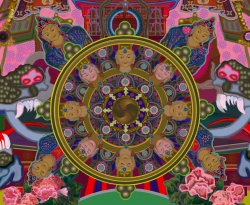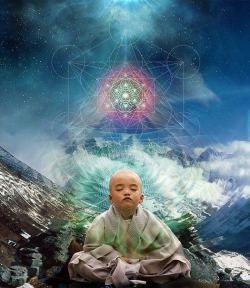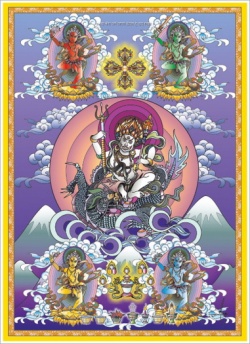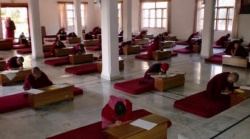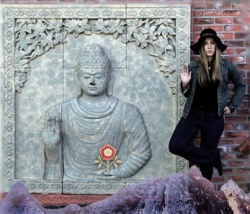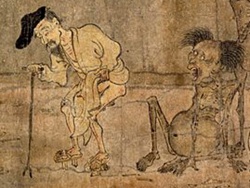Zhentong view
The Zhentong view of emptiness was taught by the Buddha, elaborated in India, and later transmitted in Tibet.
Among the early Tibetan authors on Zhentong was Yumo Mikyo Dorje, an 11th century Kalachakra yogi.
He was a disciple of Somanatha, the Sanskrit Pandit and Kalachakra master from Kashmir who translated the Vimalaprabha into Tibetan with Dro Lotsawa.
Yumo Mikyo Dorje received the Zhentong teachings while practicing the Kalachakra six-branch yoga in the Mt. Kailash area of Western Tibet, and later taught Zhentong as a "secret doctrine" (lkog pa'i chos) to his closest disciples.
In 1294, Kunpang Tukje Tsondru (1243-1313) founded a monastery in Jomonang, which gave the name to the lineage. This monastery was modeled on the traditional design of the Kingdom of Shambhala.
Tukje Tsondru also arranged and gathered the Six Yoga Kalachakra practice traditions that existed in Tibet at that time.
Kunkhyen Dolpopa Sherab Gyaltsen (1292-1361) settled in Jomonang after studying each of the existing Buddhist traditions in Tibet, including Kagyu, Nyingma, and Sakya (in which he was ordained).
Kunchen Dolpopa served as abbot of Jonang Monastery, and in the year 1333 completed the Great Stupa of Jonang.
Kunkhyen Dolpopa was the first Jonang master to extensively teach Zhentong.
In his most famous work, Mountain Dharma: Ocean of Definitive Meaning (ri chos nges don rgya mtsho), Kunkhyen Dolpopa clarified the Zhentong view.
These are referred to as the teachings of the "Heart's Essence" (snying po'i don).
As Kunkhyen Dolpopa's Mountain Dharma and other Jonang texts were banned in the 17th century, they became extremely rare.
In the 1970s and 1980s a few of these texts were re-discovered and re-printed, notably through the agency of His Holiness Dilgo Khyentse Rinpoche.
The Jonang produced a number of renowned Buddhist scholars.
Among these was Jetsun Taranatha (1575-1634), who founded Takten Phuntsok Ling Monastery (near Shigatse).
He is widely known as one of the greatest scholars, historians, and practitioners of his time.
Two of Jetsun Taranatha's best known works are his History of Buddhism in India and Origins of the Tara Tantra (The Golden Rosary).
Given the true establishment of Buddha nature (tathagatagarbha) in all sentient beings, the Jonangpa propounded the value of non-action and non-striving, which the Gelukpa associated with the teachings of medieval Chan Buddhism in China (Zen Buddhism in Japan).
While the Gelukpa embraced the Jonang teaching on the Kalachakra, they ultimately opposed the Jonang for the Zhentong teachings.
In the mid 17th century, the Jonang came under attack by the Geluk under the rule of the 5th Dalai Lama.
The Geluk declared the Zhentong view of emptiness to be heretical, sealed Jonang libraries, burned Jonang books, and forcibly closed or annexed Jonang monasteries.
Modern historians have identified two other reasons which likely led the Gelukpa to suppress the Jonang.
First, the Jonangpa taught that large gifts of property to monasteries did not help one achieve enlightenment.
This undercut the financial practices of the Gelukpa, who were growing rapidly through those very means.
Second, and more significantly, the Jonangpa had political ties that were very vexing to the Gelukpa.
The Jonangpa, along with the Kagyupa, were historical allies of the powerful house of Tsang, which was vying with the 5th Dalai Lama for control of central Tibet.
Following this repression, it was generally believed that the Jonang tradition had become extinct.
However, as many as seventy Jonang monasteries are still active in isolated areas of Tibet and China, including the main monastery called Tsangwa, located in Dzamthang, and others in the Amdo region.
Today, Dzamthang Tsangwa Monastery is home to approximately 1,500 monks, and there are more than 5,000 Jonang monks in this remote region of Tibet.
There are also Jonang practice centers in China, Taiwan, Nepal, and the USA.
As a gesture of his support, His Holiness the 14th Dalai Lama gifted the Jonang their first and only monastery in exile in Shimla, Northern India.
Takten Phuntsok Ling Monastery is now the main center for the Jonang outside of Tibet.
For the initial 300-years of the Jonangpa, the primary lineage-heir was the master who held the seat of Jomonang, and later of Jetsun Taranatha's Takten Damcho Ling Monastery (Phuntsok Ling).
Since that time, although the spiritual authority of the Jonang has never rested on any one individual, the abbot of Dzamthang Tsangwa Monastery has held great authority and influence within the tradition.
Recently, His Holiness the 14th Dalai Lama appointed the 9th Kalkha Rinpoche to oversee the affairs of the Jonang monastery in Shimla, India, Takten Phuntsok Choling.
Honoring the claim that Khalkha Rinpoche is the reincarnation of Jetsun Taranatha, His Holiness has also appointed him as the main representative for the Jonang.
However, Kalkha Rinpoche is effectively the head of the Geluk tradition in Mongolia, and thus perhaps not the most suitable candidate to represent and expound the teachings of Kunkhyen Dolpopa and the Jonang masters.
Under these conditions, with the officially designated leadership of the lineage schooled in Geluk (rangtong) doctrine and formally affiliated with the sect that instituted the 17th century persecution, and in obedience to our Teacher, Kyabje Tash Norbu Rinpoche, we have chosen to remain faithful to the original Jonang practice of avoiding official designations of leadership, and allowing the quality and power of the Dharma activities of each Teacher and Sangha to manifest unimpeded.
The Jonang teaching is based on the union of the Profound View and Vast Conduct lineages of the Protectors Nagarjuna and Asanga, neither overestimating nor denigrating either, and is therefore called the 'Definitive Meaning'.
While some schools give 'provisional' status to the First, Second, or Third turnings of the Wheel of Dharma, Kunkhyen Dolpopa established that the Definitive Meaning can be found in all three if one applies the correct method of analysis and relies on the direct perception of samadhi.
While the Tathagata sutras are certainly embraced (especially the Uttaratantra) by Jonangpas, so are all the Teachings of the Buddha, without exception.
